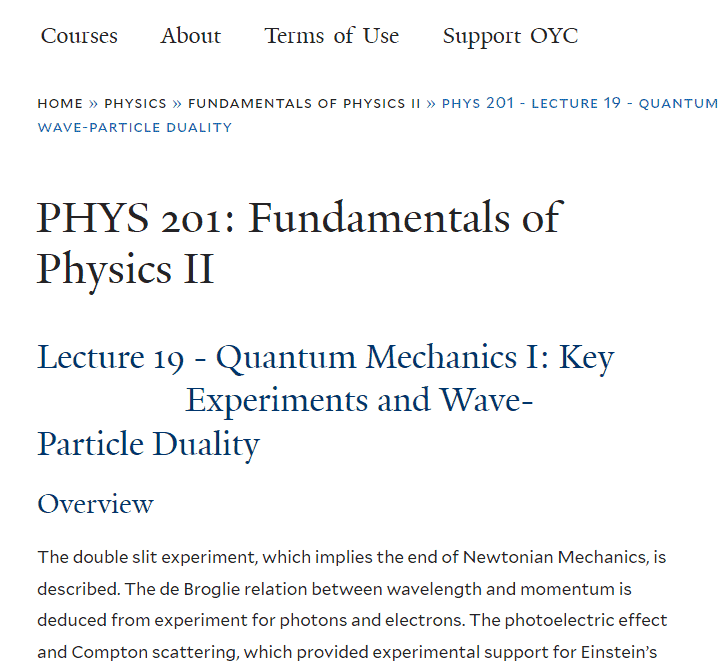Statistics-lab™可以为您提供yale.edu PHYS201 Quantum mechanics量子力学的代写代考和辅导服务!

PHYS201 Quantum mechanics课程简介
The double slit experiment, which implies the end of Newtonian Mechanics, is described. The de Broglie relation between wavelength and momentum is deduced from experiment for photons and electrons. The photoelectric effect and Compton scattering, which provided experimental support for Einstein’s photon theory of light, are reviewed. The wave function is introduced along with the probability interpretation. The uncertainty principle is shown to arise from the fact that the particle’s location is determined by a wave and that waves diffract when passing a narrow opening.
PREREQUISITES
The double-slit experiment is a classic experiment in physics that demonstrates the wave-particle duality of light and matter. In this experiment, a beam of particles, such as electrons or photons, is passed through a barrier with two slits. Behind the barrier, a detector measures the intensity of the particles that have passed through the slits and hit a screen.
Classically, one would expect the particles to form two distinct bands on the screen, corresponding to the two slits. However, what is observed is an interference pattern, with bright and dark fringes. This pattern can only be explained if the particles behave like waves, with the two slits acting as sources of coherent waves that interfere with each other.
The de Broglie relation between wavelength and momentum is a fundamental equation of quantum mechanics that relates the momentum of a particle to its wavelength. It is given by λ = h/p, where λ is the wavelength, p is the momentum, and h is Planck’s constant.
PHYS201 Quantum mechanics HELP(EXAM HELP, ONLINE TUTOR)
[20 pts] Consider the wavefunction $\phi(x) \equiv\langle x \mid \phi\rangle=\mathcal{N} e^{-\frac{(x-x 0)^2}{2 \sigma^2}}$. What should the value of $\mathcal{N}$ be so that $\langle\phi \mid \phi\rangle=1$ ?
What is the probability to find the system between position $x$ and $x+d x$ ?
Calculate the expectation value $\langle X\rangle \equiv\langle\phi|X| \phi\rangle$ and the uncertainty $\Delta X=\sqrt{\left\langle X^2\right\rangle-\langle X\rangle^2}$.
Note: $X$ is the position operator, satisfying $X|x\rangle=x|x\rangle$. Does the interpretation of $\langle X\rangle$ as the average value of $x$ and $\Delta x$ as the ‘spread’ around the average make sense for this example?
Solution:
$$
1=\langle\phi \mid \phi\rangle=\int d x\langle\phi \mid x\rangle\langle x \mid \phi\rangle=\int d x|\phi(x)|^2=\mathcal{N}^2 \int d x e^{-\frac{(x-x)^2}{\sigma^2}}=\mathcal{N}^2 \sqrt{\pi \sigma^2} .
$$
Normalization thus requires $\mathcal{N}=\frac{1}{\sqrt[4]{\pi \sigma^2}}$
The probability to find the system between $x$ and $x+d x$ is
$$
\begin{aligned}
& \qquad d P(x)=|\langle x \mid \phi\rangle|^2 d x=\frac{1}{\sqrt{\pi} \sigma} e^{-x^2 / \sigma^2} d x \
& \langle X\rangle=\langle\phi|X| \phi\rangle=\int d x\langle\phi|X| x\rangle\langle x \mid \phi\rangle=\int d x x\langle\phi \mid x\rangle\langle x \mid \phi\rangle=\int_{-\infty}^{\infty} d x x|\phi(x)|^2=\int_{-\infty}^{\infty} d x \frac{e^{-\frac{\left(x-x_0\right)^2}{\sigma^2}}}{\sqrt{\pi} \sigma}=x_0 . \
& \text { Similarly } \
& \qquad\left\langle X^2\right\rangle=\frac{1}{\sqrt{\pi} \sigma} \int_{-\infty}^{\infty} d x x^2 e^{-\frac{\left(x-x_0\right)^2}{\sigma^2}}=x_0^2+\frac{\sigma^2}{2} .
\end{aligned}
$$
This gives:
$$
\Delta X=\sqrt{\left\langle X^2\right\rangle-\langle X\rangle^2}=\sqrt{x_0^2+\frac{\sigma^2}{2}-x_0^2}=\frac{\sigma}{\sqrt{2}} .
$$
Since the probability density is a Gaussian centered at $x_0$ with width $\sigma$, interpreting $\langle X\rangle$ as the average and $\Delta X$ as the ‘spread’ makes sense.
[10 pts] Consider a particle whose wavefunction is that used in the previous problem. The position of the particle is then measured with a resolution of $\Delta$. What is the probability that the particle is found within $\pm \Delta / 2$ of position $x$ ? What is the state vector of the system immediately after the measurement, assuming that the particle was indeed found within $\pm \Delta / 2$ of position $x$ ?
Solution:
Let $P(x, \Delta)$ be the probability that the system is found within $\pm \Delta$ of $\mathrm{x}$.
$$
P(x, \Delta)=\int_{x-\Delta / 2}^{x+\Delta / 2} d x^{\prime}\left|\psi\left(x^{\prime}\right)\right|^2=\int_{x-\Delta / 2}^{x+\Delta / 2} d x^{\prime} \frac{e^{-x^{\prime 2} / \sigma^2}}{\sqrt{\pi} \sigma}
$$
This integral expression is sufficient to receive full credit, but if you like you can plug this into mathematica, to get
$$
\frac{1}{2}\left[\operatorname{Erf}\left(\frac{\Delta-2 x}{2 \sigma}\right)-\operatorname{Erf}\left(\frac{\Delta+2 x}{2 \sigma}\right)\right]
$$
The state after the measurement is
$$
\left|\psi^{\prime}\right\rangle=\frac{1}{\sqrt{P(x, \Delta)}} \int_{x-\Delta / 2}^{x+\Delta / 2} d x^{\prime}\left|x^{\prime}\right\rangle\left\langle x^{\prime} \mid \psi\right\rangle=\frac{1}{\sqrt{P(x, \Delta)}} \int_{x-\Delta / 2}^{x+\Delta / 2} d x^{\prime}\left|x^{\prime}\right\rangle \frac{e^{-x^{\prime 2} / 2 \sigma^2}}{\sqrt[4]{\pi \sigma^2}}
$$
Textbooks
• An Introduction to Stochastic Modeling, Fourth Edition by Pinsky and Karlin (freely
available through the university library here)
• Essentials of Stochastic Processes, Third Edition by Durrett (freely available through
the university library here)
To reiterate, the textbooks are freely available through the university library. Note that
you must be connected to the university Wi-Fi or VPN to access the ebooks from the library
links. Furthermore, the library links take some time to populate, so do not be alarmed if
the webpage looks bare for a few seconds.

Statistics-lab™可以为您提供yale.edu PHYS201 Quantum mechanics量子力学的代写代考和辅导服务! 请认准Statistics-lab™. Statistics-lab™为您的留学生涯保驾护航。